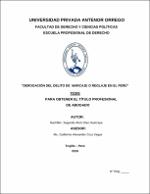Mostrar el registro sencillo del ítem
Derogación del delito de marcaje o reglaje en el Perú
| dc.contributor.advisor | Cruz Vegas, Guillermo Alexander | |
| dc.contributor.author | Díaz Huarcaya, Segundo Alvin | |
| dc.creator | Díaz Huarcaya, Segundo Alvin | |
| dc.date.accessioned | 2019-07-16T16:50:15Z | |
| dc.date.available | 2019-07-16T16:50:15Z | |
| dc.date.issued | 2019 | |
| dc.identifier.uri | https://hdl.handle.net/20.500.12759/5157 | |
| dc.description.abstract | En el presente trabajo de investigación (tesis) se pone sobre el tapete un tipo penal de nuestra parte especial, que se encuentra ubicado en el artículo 317-A del Código penal; sometiéndolo a un test de constitucionalidad a partir de los principios de legalidad y de lesividad, para poder indicar que este tipo penal es contrario a estos postulados; en ese sentido, se formuló el siguiente enunciado del problema: ¿Cuál es el fundamento jurídico para que el delito de marcaje o reglaje regulado en el código penal peruano (artículo 317-A) sea derogado? ”, ante tal cuestión, se estableció como respuesta tentativa que “El fundamento para derogar el delito de marcaje o reglaje regulado el código penal peruano (artículo 317-A) está dado, porque este constituye un adelantamiento de la barrera de punibilidad que no permite diferenciar actos permitidos de los prohibidos; vulnera el principio de determinación de los tipos penales, al no delimitar de forma exhaustiva la conducta típica; y, no protege la tranquilidad pública, sino que genera inseguridad jurídica; en ese sentido, nos trazamos como objetivo general: “determinar cuál es el fundamento jurídico para que el delito de marcaje o reglaje regulado en el código penal peruano (artículo 317-A) sea derogado”. Luego de emplear el método exegético y análisis de los materiales llegamos a comprobar que nuestra hipótesis de esta investigación simple y dogmática se demostró. | es_PE |
| dc.description.abstract | In the present research work (tesis) a penalty type of our special part is placed on the table, which is located in article 317-A of the Penal Code; subjecting it to a test of constitutionality based on the principles of legality and of lesividad, to be able to indicate that this criminal type is contrary to these postulates; in that sense, the following statement of the problem was formulated: What is the legal basis for the crime of regulation and marking regulated by the Peruvian penal code (article 317-A) to be repealed? “, In response to this question, it was established as a tentative response that“ The basis for repealing the offense of regulated regulation and marking of the Peruvian criminal code (article 317-A) is given, because this constitutes an advancement of the punitive barrier that does not allow differentiate allowed acts from those that are prohibited; it violates the principle of determination of the criminal types, by not exhaustively defining the typical conduct; and, it does not protect public tranquility, but it generates legal uncertainty; in that sense, we set ourselves as a general objective: “to determine what the legal basis is for the crime of regulation and marking regulated by the Peruvian penal code (article 317-A) to be repealed“. After using the exegetical method and analysis of the materials we come to verify that our hypothesis of this is simple and dogmatic research was demonstrated. | en_US |
| dc.description.uri | Tesis | es_PE |
| dc.format | application/pdf | es_PE |
| dc.language.iso | spa | es_PE |
| dc.publisher | Universidad Privada Antenor Orrego - UPAO | es_PE |
| dc.relation.ispartofseries | T_DERE_467 | |
| dc.rights | info:eu-repo/semantics/openAccess | es_PE |
| dc.source | Universidad Privada Antenor Orrego | es_PE |
| dc.source | Repositorio Institucional - UPAO | es_PE |
| dc.subject | Delito de marcaje | es_PE |
| dc.subject | Fundamento jurídico | es_PE |
| dc.subject | Derogación | es_PE |
| dc.subject | Inseguridad jurídica | es_PE |
| dc.title | Derogación del delito de marcaje o reglaje en el Perú | es_PE |
| dc.type | info:eu-repo/semantics/bachelorThesis | es_PE |
| thesis.degree.level | Título Profesional | es_PE |
| thesis.degree.grantor | Universidad Privada Antenor Orrego. Facultad de Derecho y Ciencias Políticas | es_PE |
| thesis.degree.name | Abogado | es_PE |
| thesis.degree.discipline | Derecho | es_PE |
Ficheros en el ítem
Este ítem aparece en la(s) siguiente(s) colección(es)
-
Derecho [422]

